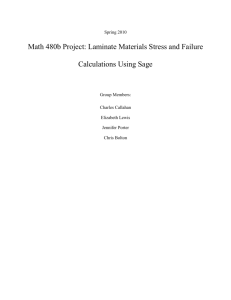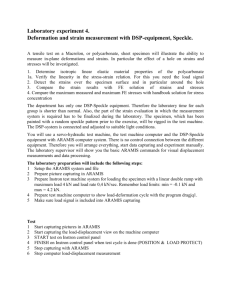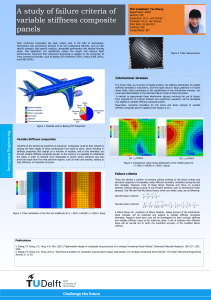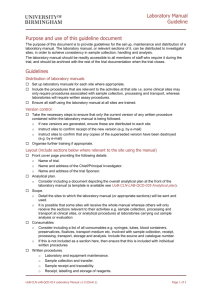Analytical Solution
advertisement
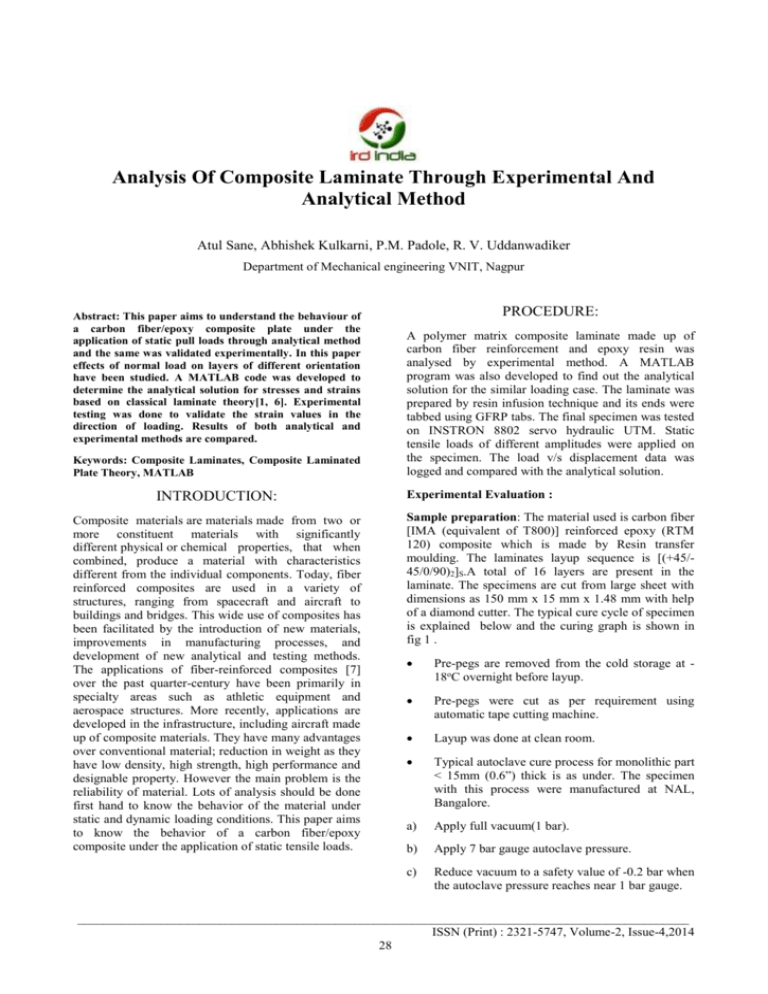
International Journal on Mechanical Engineering and Robotics (IJMER) _______________________________________________________________________________________________ Analysis Of Composite Laminate Through Experimental And Analytical Method Atul Sane, Abhishek Kulkarni, P.M. Padole, R. V. Uddanwadiker Department of Mechanical engineering VNIT, Nagpur Abstract: This paper aims to understand the behaviour of a carbon fiber/epoxy composite plate under the application of static pull loads through analytical method and the same was validated experimentally. In this paper effects of normal load on layers of different orientation have been studied. A MATLAB code was developed to determine the analytical solution for stresses and strains based on classical laminate theory[1, 6]. Experimental testing was done to validate the strain values in the direction of loading. Results of both analytical and experimental methods are compared. Keywords: Composite Laminates, Composite Laminated Plate Theory, MATLAB INTRODUCTION: Composite materials are materials made from two or more constituent materials with significantly different physical or chemical properties, that when combined, produce a material with characteristics different from the individual components. Today, fiber reinforced composites are used in a variety of structures, ranging from spacecraft and aircraft to buildings and bridges. This wide use of composites has been facilitated by the introduction of new materials, improvements in manufacturing processes, and development of new analytical and testing methods. The applications of fiber-reinforced composites [7] over the past quarter-century have been primarily in specialty areas such as athletic equipment and aerospace structures. More recently, applications are developed in the infrastructure, including aircraft made up of composite materials. They have many advantages over conventional material; reduction in weight as they have low density, high strength, high performance and designable property. However the main problem is the reliability of material. Lots of analysis should be done first hand to know the behavior of the material under static and dynamic loading conditions. This paper aims to know the behavior of a carbon fiber/epoxy composite under the application of static tensile loads. PROCEDURE: A polymer matrix composite laminate made up of carbon fiber reinforcement and epoxy resin was analysed by experimental method. A MATLAB program was also developed to find out the analytical solution for the similar loading case. The laminate was prepared by resin infusion technique and its ends were tabbed using GFRP tabs. The final specimen was tested on INSTRON 8802 servo hydraulic UTM. Static tensile loads of different amplitudes were applied on the specimen. The load v/s displacement data was logged and compared with the analytical solution. Experimental Evaluation : Sample preparation: The material used is carbon fiber [IMA (equivalent of T800)] reinforced epoxy (RTM 120) composite which is made by Resin transfer moulding. The laminates layup sequence is [(+45/45/0/90)2]S.A total of 16 layers are present in the laminate. The specimens are cut from large sheet with dimensions as 150 mm x 15 mm x 1.48 mm with help of a diamond cutter. The typical cure cycle of specimen is explained below and the curing graph is shown in fig 1 . Pre-pegs are removed from the cold storage at 18oC overnight before layup. Pre-pegs were cut as per requirement using automatic tape cutting machine. Layup was done at clean room. Typical autoclave cure process for monolithic part < 15mm (0.6”) thick is as under. The specimen with this process were manufactured at NAL, Bangalore. a) Apply full vacuum(1 bar). b) Apply 7 bar gauge autoclave pressure. c) Reduce vacuum to a safety value of -0.2 bar when the autoclave pressure reaches near 1 bar gauge. _______________________________________________________________________________________________ ISSN (Print) : 2321-5747, Volume-2, Issue-4,2014 28 International Journal on Mechanical Engineering and Robotics (IJMER) _______________________________________________________________________________________________ of the prepared laminate used for the experimental work is shown in fig 3. Figure 3: FV & TV Laminate Dimensions (all dimensions in mm) Fig1: Curing graph d) Set heat up rate from room temperature to 180oC±5oC to achieve an actual component heat up rate between 1-2oC/ minute. e) Hold at 180oC±5oC for 120 minutes±5 minutes. f) Cool component at an actual cool down rate of 24oC/minute. g) Vent autoclave pressure when the component reaches 60oC or below. h) Tabs of glass fiber reinforced epoxy composite, having size 40 mm x 15 mm x 3mm are attached to the specimens to achieve proper grip of the specimen in jaw. Tabs are joined by help of araldite and hardener. A photograph of the specimen with tabs is shown in figure 2. The material is a transversely isotropic material that is it has same material properties along two material axes. For a transversely isotropic material 5 material constants are required to completely define the material. The material properties are often supplied in the Major Poisson’s ratio form. However if the basic 5 material properties which are longitudinal Elastic modulus, transverse Elastic modulus, LongitudinalTransverse Poisson’s ratio, In-plane Shear modulus and Transverse-transverse Poisson’s ratio are known, remaining 4 material constants can be derived easily. The Material properties of the composite material are given in table 1. Table 1: Material Properties Modulus of Elasticity (GPa) E1 128 E2 10 E3 10 Shear Modulus (GPa) G12 4.8 G23 3.2 G13 4.8 Poisson’s Ratio ν12 ν 23 ν 13 0.31 0.52 0.31 Analytical Solution : Figure 2 : Final Specimen Test Equipment Details: All the tests were conducted on INSTRON8802. The machine has a load cell of 250 kN and its a servo hydraulic test system. The load cell can be auto tuned for different type of materials. It allows the user to perform Tensile, Compression, Bend, Fatigue, Fracture Toughness tests. In the current study tests were performed at room temperature and in laboratory air atmosphere. The specimen was fixed in wedge grips and the PID gains were automatically adjusted by the machine. Experimental Procedure: The load v/s displacement data of the specimen was acquired experimentally on INSTRON 8802 250 kN servo hydraulic test system. The specimen was gripped onto the machine with a gripping pressure of 2.5 bar. Different static loads were applied by the controller by increasing the load gradually. For each of the applied load corresponding displacement was logged using DAX software of INSTRON. The overall dimensions An analytical solution based on the classical laminated plate theory [1] was implemented to find stresses and strains on top bottom and mid plane of each layer in the composite laminate. The classical laminated plate theory is an extension of classical plate theory to laminated plates. In this theory the in-plane displacements are assumed to vary linearly through the thickness and transverse displacements are assumed to be constant through the thickness i.e. transverse strains are assumed to be zero. The stresses and strains in any layer are calculated from the strains and curvature at the laminate midplane. Firstly the elements of reduced stiffness matrix for the material are calculated from the material properties as follows: 1 Q 11 2 Q12 0 12 Q12 Q22 0 0 1 0 2 Q66 12 Equation 1 _______________________________________________________________________________________________ ISSN (Print) : 2321-5747, Volume-2, Issue-4,2014 29 International Journal on Mechanical Engineering and Robotics (IJMER) _______________________________________________________________________________________________ 0 x x x 0 z y y y 0 xy xy xy Where, Q 1 E Q E Q 1 12 Q 1 11 12 21 22 2 12 12 66 E 2 1 12 21 G 12 21 Then based on laminate code the transformed reduced stiffness matrix for each layer is calculated, which are required to find out the extensional, coupling and the bending stiffness matrix. The transformed reduced stiffness matrix for each layer is calculated as, cos 2 θ T = [ sin2 θ −sinθcosθ sin2 θ 2sinθcosθ cos 2 θ −sinθcosθ ] sinθcosθ cos 2 θ − sin2 θ 1 0 0 R = [0 1 0] 0 0 2 Q = [T]-1[Q][R][T][R]-1 Q11 Q12 Q Q 21 Q 22 Q16 Q 26 Q16 Q 26 Q 66 Where, θ is the angle of fibre orientation in any particular layer. Then from the known loads (Nx ,Ny,Nxy) and known moments (Mx,My, Mxy), mid-plane strains and curvature are found by solving the six simultaneous equations. 0 N x A11 A12 A16 x B11 B12 B16 x 0 N y A12 A22 A26 y B12 B22 B26 y A A A 0 B B B N xy 16 26 66 xy 16 26 66 xy 0 M x B11 B12 B16 x D11 D12 D16 x 0 M y B12 B22 B26 y D12 D22 D26 y 0 M xy B16 B26 B66 xy D16 D26 D66 xy where εx0, εy0, εxy0 are mid-plane strains and κx0, κy0, κxy0 are mid-plane curvatures and z z 1 B Q z z 2 1 D Q z z 3 n Aij Q ij k 1 k 1 k k n ij k 1 2 ij k k ij k n ij k 1 2 k 1 3 k 3 k 1 where Zk and Zk-1are the distance of the Kth and K-1th layer from the midplane respectively. From obtained mid-plane strains and curvatures strain components and corresponding stress components at any distance z from the mid-plane can be calculated. The stresses in ith layer are calculated as Q Q12 Q16 0x x 11 x y Q 21 Q 22 Q 26 0y z y xy Q16 Q 26 Q66 0 xy i xy i A MATLAB code [2,3] was written for getting the analytical solution since finding strains and stresses in each layer of the laminate is a quite lengthy process, especially when numbers of layers are more as it is in this case. Also the use of software would eliminate any chances of errors in calculation. The code developed is based on the above procedure and is a generalized program which can be used to solve problems involving any number of layers with varying fiber orientation angles and varying thickness. The input arguments required are material properties, laminate code, layer thickness and loads applied. The analytical solution was calculated by using the same load values as applied in the experimental and finite element analysis. A part of the output of the program is shown. Analysis of Composite Laminates ******************************************** ************** Enter Elastic Modulus in Longitudinal Direction E1 in Pa 128e9 Enter Elastic Modulus in Transverse Direction E2 in Pa 10e9 Enter Major Poisson’s Ratio Pr12 0.31 Enter in-plane Shear Modulus G12 in Pa 4.8e9 The reduced stiffness matrix is C= 1.2897e+011 3.1235e+009 3.1235e+009 1.0076e+010 0 0 4.8e+009 0 0 Starting with Top layer Enter the Laminate code in degrees in the form of a row matrix as [angle1 angle2 angle3 ...] [45 -45 0 90 45 -45 0 90 90 0 -45 45 90 0 -45 45] no. of Layers are 16 Enter the thickness of Lamina in m = 0.0925e-3 Total Laminate Thickness is 1.480000e-003 m The Transformed Reduced Stiffness Matrix for each ply is for 45 deg ply ans = 4.1123e+010 3.1523e+010 .9723e+010 _______________________________________________________________________________________________ ISSN (Print) : 2321-5747, Volume-2, Issue-4,2014 30 International Journal on Mechanical Engineering and Robotics (IJMER) _______________________________________________________________________________________________ 3.1523e+010 4.1123e+010 .9723e+010 2.9723e+010 2.9723e+010 3.3199e+010 for -45 deg ply ans = 4.1123e+010 3.1523e+010 -2.9723e+010 3.1523e+010 4.1123e+010 -2.9723e+010 -2.9723e+010 -2.9723e+010 3.3199e+010 for 90 deg ply ans = 1.0076e+010 3.1235e+009 1.2897e+011 00 C C C C C C 12 for 0 deg ply ans = 1.2897e+011 3.1235e+009 3.1235e+009 1.0076e+010 0 0 4.8e+009 x 23 12 0 0 0 0 3.1235e+009 4.8e+009 Enter the Forces and Moments in N/m Enter Nx 0 Enter Ny1398600 Enter Nxy 0 Enter Mx 0 Enter My 0 Enter Mxy 0 Based on above inputs the code then calculates strains and stresses in global and local coordinates for top, middle and bottom plane of each layer. The MATLAB code is extended to calculate the strain in z direction εz by using the 6x6 stiffness matrix of transversely isotropic material and the normal strains in x and y direction for which the 5th material property i.e. transverse-transverse poissons ratio (ν23) is required. εzis calculated by substituting σz=0 (Plane Stress condition) as Figure 4: Global Strain Distribution Through Laminate Thickness y x 22 23 z 0 y z 22 Finally the analytical results were compared with experimental and finite element results. Results: Experimental Results: The experimental results were logged in the form of a stress – strain curve and results were logged, fig. 6 shows the stress strain relationship for the material. The stress-strain curve shows the relation between the applied stress level and corresponding strains in the direction of loading. The stress level was calculated by using the direct stress relation between force and area of cross section as σ= P A Figure 5: Global Stress Distribution through Laminate Thickness Analytical Solution: Analytical results were obtained by the MATLAB code. The aforementioned load conditions, material properties and fiber orientation sequence were entered as input to the program, and calculated directional stresses and strains are presented. Table 2: Strains Calculated by Analytical Method Code 45 -45 0 90 45 -45 0 90 εx -0.00593 -0.00593 -0.00593 -0.00593 -0.00593 -0.00593 -0.00593 -0.00593 Analytical solution εy ϒxy 0.018939 -2.6834E-18 0.018939 -2.3256E-18 0.018939 -1.9678E-18 0.018939 -1.61E-18 0.018939 -1.2522E-18 0.018939 -8.9445E-19 0.018939 -5.3667E-19 0.018939 -1.7889E-19 εz -0.00725 -0.00725 -0.00725 -0.00725 -0.00725 -0.00725 -0.00725 -0.00725 Table 3: Stress Calculated by Analytical Method Cod σx(Pa) σy(Pa) τxy(Pa) e 45 3.53E+08 5.92E+08 3.87E+08 -45 3.53E+08 5.92E+08 -3.87E+08 _______________________________________________________________________________________________ ISSN (Print) : 2321-5747, Volume-2, Issue-4,2014 31 International Journal on Mechanical Engineering and Robotics (IJMER) _______________________________________________________________________________________________ 0 90 45 -45 0 90 -7.06E+08 -5.97E+05 3.53E+08 3.53E+08 -7.06E+08 -5.97E+05 1.72E+08 2.42E+09 5.92E+08 5.92E+08 1.72E+08 2.42E+09 transformed reduced stiffness matrices for these layers (see program output) in which Q and Q are zero. -9.45E-09 -7.73E-09 3.87E+08 -3.87E+08 -1.72E-09 -8.59E-10 16 26 However for the angled plies (+45°,-45°) these terms in the transformed reduced stiffness matrix are non-zero, as a result of this coupling takes place between the normal and shearing terms of strains and stresses. Hence for these layers, shear stresses are non-zero even though the shear strains are zero. These layers are generally orthotropic laminae. In Table 2 and 3 the strains and stresses are shown only for first 8 layers. Since the plate is symmetric [4, 5], the results are repeated symmetrically except for shear strain which are symmetric only in magnitude. These layer wise stress and strain distributions in global coordinates are shown in fig 4 and 5. Comparison with Experimental Results To compare analytical solutions with experimental, similar graphs were created. In MATLAB, the stress strain relation was computed by putting different load values within the desired range and corresponding strain in global y direction was noted. Fig 6 shows the analytical Stress-Strain curve. Fig. 6 shows that the stress-strain relationship is linear and show good congruence with experimental results. The error in strain obtained from analytical method at maximum load applied is 6.27% REFERENCES: Figure 6: Comparison of Analytical and Experimental Results [1] Mechanics of composite materials; 2nd edition, Kaw Autar K., CRC press. [2] G. Z. Voyiadjis and P. I. Kattan, “Mechanics of Composite Materials with MATLAB,” Springer Netherlands, Dordrecht, 2005. [3] Avinash Ramsaroop, Krishnan Kanny, “Using MATLAB to Design and Analyse Composite Laminates”, Engineering, 2010, 2, 904-916. [4] Z. Vnučec, Influence of lamination angles on the stresses and strains values in the laminated composite plates, ATDC'02 - 1st DAAAM International Conference on Advanced Technologies for Developing Countries, Proceedings, pp 93-98, Slavonski Brod, 2002. [5] Z. Vnučec, Stress and strain analysis of symmetric laminated composite plates, TMT 2000 – Trends in the Development of Machinery and Associated Technology, Proceedings, pp 267-274, Zenica, 2000. [6] Berthelot J-M. Classical laminate theory. In: Composite materials, Mechanical engineering series. New York: Springer; 1999. p. 287–311. [7] Z. Vnučec, Engineering Properties and Applications of the Laminated Composite Materials, RIM'99 – Revitalization and Modernization of Production, Proceedings, pp 71-78, Bihać, 1999. CONCLUSIONS: It is observed that the values of shear strains are very low which theoretically should be zero. For layers of orientation 0° and 90°, shear stresses are also very low. This is because these layers are specially orthotropic as there is no coupling between normal stresses and shear strains and vice versa, which is obvious from the _______________________________________________________________________________________________ ISSN (Print) : 2321-5747, Volume-2, Issue-4,2014 32

